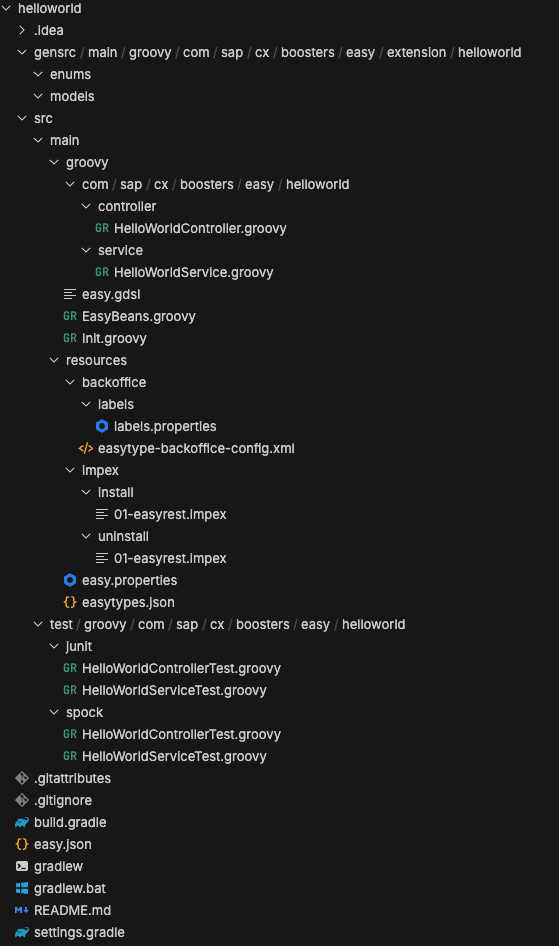Easy Extension
An Easy Extension is an encapsulated piece of software code that extends SAP Commerce Cloud functionality by either modifying existing features or introducing new features. With an Easy Extension, you link up in one place all the functionality that covers a certain field of use.
How is an Easy Extension different from the Regular SAP Commerce Cloud Extensions?
The difference between the SAP Commerce Cloud Extension and an Easy Extension can be understood from the following table:
Table | Difference between SAP Commerce Cloud Extension and an Easy Extension
Characteristics | SAP Commerce Cloud Extension | Easy Extension |
|---|---|---|
Development Frameworks | Java, Spring, Ant | Groovy, Gradle |
Extensibility Type | In-App (Compile Time) | In-App (Runtime) |
Configuration | Inside | In an Easy Repository |
Installation | Traditional Build>Package>Deploy | At Runtime |
Reload | Restart the Server | At Runtime |
Uninstallation | Traditional Build>Package>Deploy | At Runtime |
Recommended for | Complex large developments | Simple Pluggable features, Integrations, Connectors, etc. |
Inclusion of External Libraries Supported | Yes | No |
Contents of an Easy Extension
An Easy Extension is a folder/directory structure (similar to an eclipse project / IntelliJ IDEA module) that can contain:
A manifest definition defining meta-information for the Easy Extension (
easy.json) — MandatoryGroovy based generated source code classes (inside
gensrc/main/groovy) — OptionalGroovy based main source code classes (inside
src/main/groovy) — OptionalGroovy based bean definition and declaration script (
EasyBeans.groovy) — OptionalGroovy-based script to execute after installation of the easy extension (
Init.groovy) — Optional
Groovy based main resources (inside
src/main/resources) — MandatoryAn Installation Wizard (
easy-installer-wizard.json) — OptionalA properties file to set some properties in SAP Commerce Cloud (
easy.properties) — OptionalA properties file to set some properties in SAP Commerce Cloud (
easy.properties) — OptionalA type definitions descriptor to define the SAP Commerce Cloud types (
easytypes.json) — OptionalImpEx scripts to execute during installation / uninstallation of the Easy Extension (inside
impex) — OptionalBackoffice configurations & localization (inside
backoffice) — Optional
Groovy based test source code classes (inside
src/test/groovy) — OptionalGroovy based test resources (inside
src/test/groovy) — Optional
Structure of an Easy Extension
The structure of an Easy Extension looks as:

Figure | Easy Extension Structure
Easy Extension Manifest
easy.json is the manifest file for an Easy extension, it contains the information below.
Table | Easy Extension manifest fields
Property | Mandatory | Default | Comments |
|---|---|---|---|
groupId | Yes | com.sap.cx.boosters.easy | The group id for the Easy extension. It should have the naming similar to a java package. |
id | Yes | No value | The id of the Easy extension. It should not contain any special character |
name | Yes | No value | The name of the Easy extension |
version | Yes | No value | The version of the Easy extension |
easyVersion | Yes | No value | The easy version the Easy extension built on |
thumbnail | Yes | No value | The url of the thumbnail of the Easy extension |
description | No | No value | The description of the Easy extension |
authors | No | No value | List of Easy extension authors |
vendor | No | No value | Vendor of Easy extension |
requires | No | No value | Dependencies (easy extensions, commerce extensions) of Easy extension |
Below is an example of an Easy Extension Manifest (easy.json):
Easy installation wizard
In easy-installer-wizard.json, you indicate the configuration of the schema for the wizard. Please refer to Easy Installation Wizard documentation.
Easy properties
In easy.properties, you indicate the SAP Commerce Cloud properties you want to configure. Once these properties are defined, they are available in the platform as any other properties called by ConfigurationService.
Groovy Sources
The Groovy directories (src/main/groovy and src/test/groovy) are where the Groovy code of the extension is located.
Resources and Configurations
The resources directories (src/main/resources and src/test/resources) are where the configuration resources of the extension are located.
Easy beans
In EasyBeans.groovy, you indicate the Easy beans you want to configure. Once these Easy beans are defined, they are available in SAP Commerce Cloud platform as any other Spring beans.
In the example below, we create greeterService and override priceService.
Easy ImpEx
An Easy Extension Framework importing of ImpEx scripts while installing or uninstalling an easy Extension. Following directories designate for the installation and uninstallation purposes
src/main/resources/impex/installdirectory contains the ImpEx files that are imported with installation of an Easy extension.src/main/resources/impex/uninstalldirectory contains the ImpEx files that are imported with uninstallation of an Easy extension.
Easy Init script
The Easy Init script is executed at the deployment of the extension. By default, the name of the script is Init.groovy and it is expected at the root of Groovy main folder. The name can be changed in the Easy extension definition file. This file is optional and not mandatory to include in an easy extension.
Easy Type Definitions
Please refer to Easy Type documentation. The Easy Type definitions are located at: src/main/resources/easytypes.json
Easy Backoffice Configurations
Please refer to Easy Backoffice documentation. The backoffice configurations are located at: src/main/resources/backoffice